HOMO NEANDERTHALENSIS.
VerifiedAdded on 2023/01/19
|10
|2470
|46
AI Summary
Contribute Materials
Your contribution can guide someone’s learning journey. Share your
documents today.
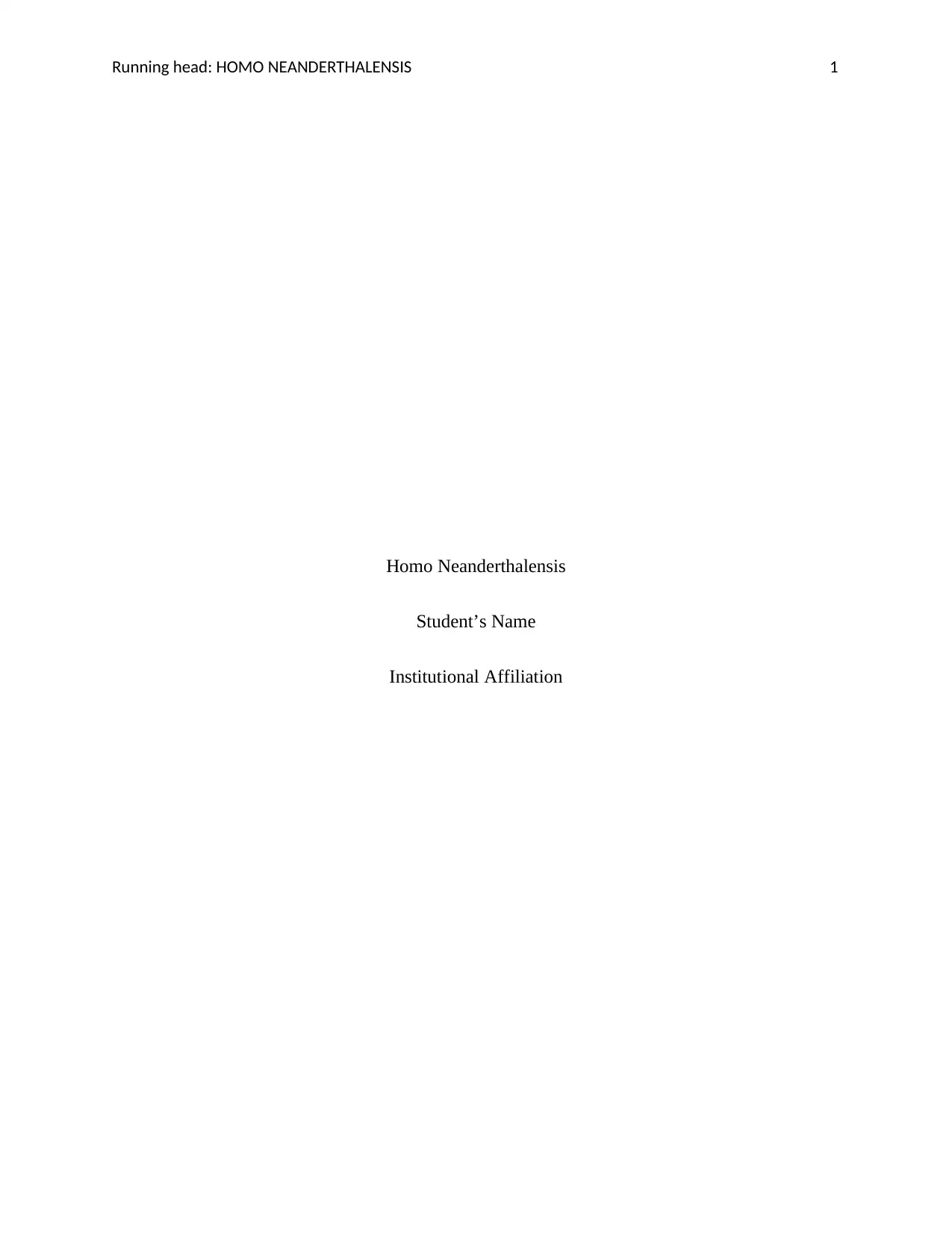
Running head: HOMO NEANDERTHALENSIS 1
Homo Neanderthalensis
Student’s Name
Institutional Affiliation
Homo Neanderthalensis
Student’s Name
Institutional Affiliation
Secure Best Marks with AI Grader
Need help grading? Try our AI Grader for instant feedback on your assignments.
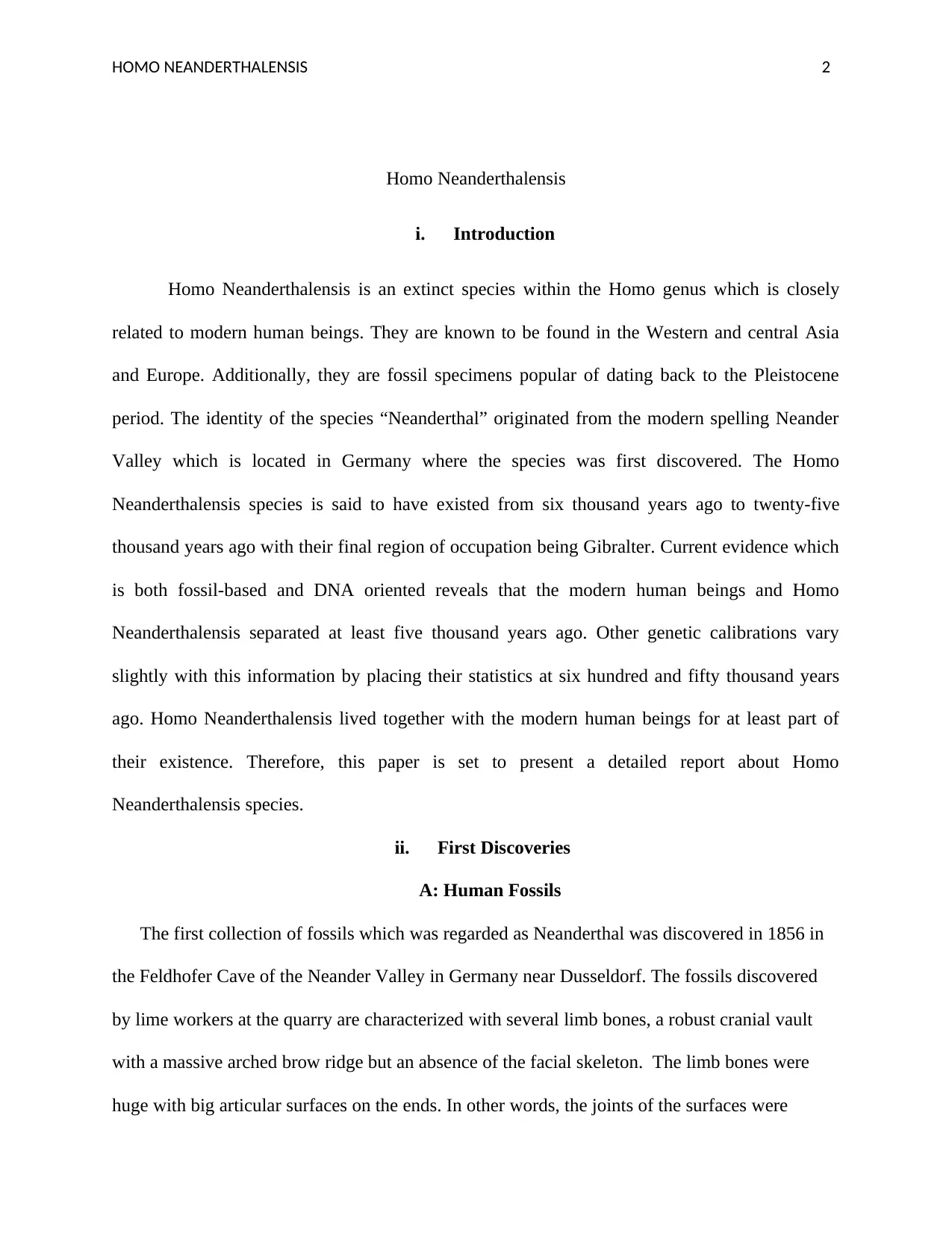
HOMO NEANDERTHALENSIS 2
Homo Neanderthalensis
i. Introduction
Homo Neanderthalensis is an extinct species within the Homo genus which is closely
related to modern human beings. They are known to be found in the Western and central Asia
and Europe. Additionally, they are fossil specimens popular of dating back to the Pleistocene
period. The identity of the species “Neanderthal” originated from the modern spelling Neander
Valley which is located in Germany where the species was first discovered. The Homo
Neanderthalensis species is said to have existed from six thousand years ago to twenty-five
thousand years ago with their final region of occupation being Gibralter. Current evidence which
is both fossil-based and DNA oriented reveals that the modern human beings and Homo
Neanderthalensis separated at least five thousand years ago. Other genetic calibrations vary
slightly with this information by placing their statistics at six hundred and fifty thousand years
ago. Homo Neanderthalensis lived together with the modern human beings for at least part of
their existence. Therefore, this paper is set to present a detailed report about Homo
Neanderthalensis species.
ii. First Discoveries
A: Human Fossils
The first collection of fossils which was regarded as Neanderthal was discovered in 1856 in
the Feldhofer Cave of the Neander Valley in Germany near Dusseldorf. The fossils discovered
by lime workers at the quarry are characterized with several limb bones, a robust cranial vault
with a massive arched brow ridge but an absence of the facial skeleton. The limb bones were
huge with big articular surfaces on the ends. In other words, the joints of the surfaces were
Homo Neanderthalensis
i. Introduction
Homo Neanderthalensis is an extinct species within the Homo genus which is closely
related to modern human beings. They are known to be found in the Western and central Asia
and Europe. Additionally, they are fossil specimens popular of dating back to the Pleistocene
period. The identity of the species “Neanderthal” originated from the modern spelling Neander
Valley which is located in Germany where the species was first discovered. The Homo
Neanderthalensis species is said to have existed from six thousand years ago to twenty-five
thousand years ago with their final region of occupation being Gibralter. Current evidence which
is both fossil-based and DNA oriented reveals that the modern human beings and Homo
Neanderthalensis separated at least five thousand years ago. Other genetic calibrations vary
slightly with this information by placing their statistics at six hundred and fifty thousand years
ago. Homo Neanderthalensis lived together with the modern human beings for at least part of
their existence. Therefore, this paper is set to present a detailed report about Homo
Neanderthalensis species.
ii. First Discoveries
A: Human Fossils
The first collection of fossils which was regarded as Neanderthal was discovered in 1856 in
the Feldhofer Cave of the Neander Valley in Germany near Dusseldorf. The fossils discovered
by lime workers at the quarry are characterized with several limb bones, a robust cranial vault
with a massive arched brow ridge but an absence of the facial skeleton. The limb bones were
huge with big articular surfaces on the ends. In other words, the joints of the surfaces were

HOMO NEANDERTHALENSIS 3
covered with cartilage. Additionally, the fossils had bone shafts which were bowed both at the
front and the back. Other fossils that resembled Neanderthals from Feldhofer were later
discovered in the 19th century and early 20th century in Belgium.
B: Animal fossils
Remains of huge extinct mammals were also found together with the human fossils. In the
first place, anatomists concluded that the remains represented the earlier human inhibitors in
Europe. Others argued that the fossils represented modern human beings (homo sapiens). The
contradiction led to Charles Darwin's publication of On the Origin of Species (1859).
iii. Morphological Characteristics
A. Body proportions and Cold Stress
Homo Neanderthalensis had unique adaptations that made them resistant to cold. Following
their facial features, the body proportions of the Homo Neanderthalensis were variable.
However, it can be generally presented that Homo Neanderthalensis possessed a broad chest with
shorter lower limb extremities compared to the upper legs and arms.
Furthermore, their legs and arms are said to be heavily muscled, strong and massive. Their
massive bodies must have protected the species from the stress of the cold winds (SNMNH,
2019). Genetic isolation is deemed to be the causal factor of the voluminous pulp cavities in the
teeth of the species which has consequently protected Homo Neanderthalensis from the impact
of cold temperatures. Despite such adaptations among the species, cold has been deemed as a
causal factor for delayed maturity of the Homo Neanderthalensis’ children. However, the recent
studies of the teeth reveal early dental development and weaning as the resultant outcomes of
cold.
B. Craniofacial Features
covered with cartilage. Additionally, the fossils had bone shafts which were bowed both at the
front and the back. Other fossils that resembled Neanderthals from Feldhofer were later
discovered in the 19th century and early 20th century in Belgium.
B: Animal fossils
Remains of huge extinct mammals were also found together with the human fossils. In the
first place, anatomists concluded that the remains represented the earlier human inhibitors in
Europe. Others argued that the fossils represented modern human beings (homo sapiens). The
contradiction led to Charles Darwin's publication of On the Origin of Species (1859).
iii. Morphological Characteristics
A. Body proportions and Cold Stress
Homo Neanderthalensis had unique adaptations that made them resistant to cold. Following
their facial features, the body proportions of the Homo Neanderthalensis were variable.
However, it can be generally presented that Homo Neanderthalensis possessed a broad chest with
shorter lower limb extremities compared to the upper legs and arms.
Furthermore, their legs and arms are said to be heavily muscled, strong and massive. Their
massive bodies must have protected the species from the stress of the cold winds (SNMNH,
2019). Genetic isolation is deemed to be the causal factor of the voluminous pulp cavities in the
teeth of the species which has consequently protected Homo Neanderthalensis from the impact
of cold temperatures. Despite such adaptations among the species, cold has been deemed as a
causal factor for delayed maturity of the Homo Neanderthalensis’ children. However, the recent
studies of the teeth reveal early dental development and weaning as the resultant outcomes of
cold.
B. Craniofacial Features
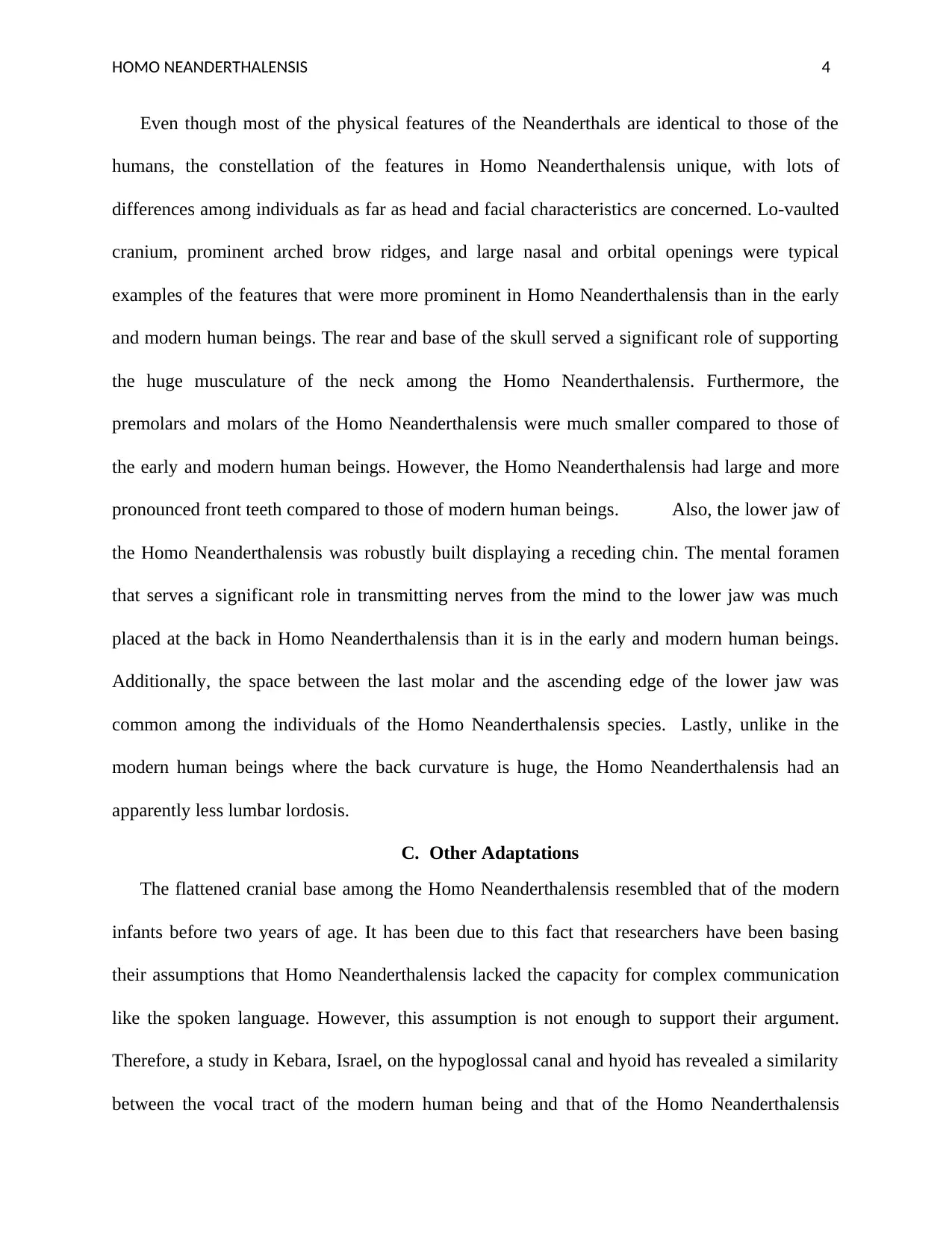
HOMO NEANDERTHALENSIS 4
Even though most of the physical features of the Neanderthals are identical to those of the
humans, the constellation of the features in Homo Neanderthalensis unique, with lots of
differences among individuals as far as head and facial characteristics are concerned. Lo-vaulted
cranium, prominent arched brow ridges, and large nasal and orbital openings were typical
examples of the features that were more prominent in Homo Neanderthalensis than in the early
and modern human beings. The rear and base of the skull served a significant role of supporting
the huge musculature of the neck among the Homo Neanderthalensis. Furthermore, the
premolars and molars of the Homo Neanderthalensis were much smaller compared to those of
the early and modern human beings. However, the Homo Neanderthalensis had large and more
pronounced front teeth compared to those of modern human beings. Also, the lower jaw of
the Homo Neanderthalensis was robustly built displaying a receding chin. The mental foramen
that serves a significant role in transmitting nerves from the mind to the lower jaw was much
placed at the back in Homo Neanderthalensis than it is in the early and modern human beings.
Additionally, the space between the last molar and the ascending edge of the lower jaw was
common among the individuals of the Homo Neanderthalensis species. Lastly, unlike in the
modern human beings where the back curvature is huge, the Homo Neanderthalensis had an
apparently less lumbar lordosis.
C. Other Adaptations
The flattened cranial base among the Homo Neanderthalensis resembled that of the modern
infants before two years of age. It has been due to this fact that researchers have been basing
their assumptions that Homo Neanderthalensis lacked the capacity for complex communication
like the spoken language. However, this assumption is not enough to support their argument.
Therefore, a study in Kebara, Israel, on the hypoglossal canal and hyoid has revealed a similarity
between the vocal tract of the modern human being and that of the Homo Neanderthalensis
Even though most of the physical features of the Neanderthals are identical to those of the
humans, the constellation of the features in Homo Neanderthalensis unique, with lots of
differences among individuals as far as head and facial characteristics are concerned. Lo-vaulted
cranium, prominent arched brow ridges, and large nasal and orbital openings were typical
examples of the features that were more prominent in Homo Neanderthalensis than in the early
and modern human beings. The rear and base of the skull served a significant role of supporting
the huge musculature of the neck among the Homo Neanderthalensis. Furthermore, the
premolars and molars of the Homo Neanderthalensis were much smaller compared to those of
the early and modern human beings. However, the Homo Neanderthalensis had large and more
pronounced front teeth compared to those of modern human beings. Also, the lower jaw of
the Homo Neanderthalensis was robustly built displaying a receding chin. The mental foramen
that serves a significant role in transmitting nerves from the mind to the lower jaw was much
placed at the back in Homo Neanderthalensis than it is in the early and modern human beings.
Additionally, the space between the last molar and the ascending edge of the lower jaw was
common among the individuals of the Homo Neanderthalensis species. Lastly, unlike in the
modern human beings where the back curvature is huge, the Homo Neanderthalensis had an
apparently less lumbar lordosis.
C. Other Adaptations
The flattened cranial base among the Homo Neanderthalensis resembled that of the modern
infants before two years of age. It has been due to this fact that researchers have been basing
their assumptions that Homo Neanderthalensis lacked the capacity for complex communication
like the spoken language. However, this assumption is not enough to support their argument.
Therefore, a study in Kebara, Israel, on the hypoglossal canal and hyoid has revealed a similarity
between the vocal tract of the modern human being and that of the Homo Neanderthalensis
Secure Best Marks with AI Grader
Need help grading? Try our AI Grader for instant feedback on your assignments.

HOMO NEANDERTHALENSIS 5
(Dorey, 2019). Additionally, the 2000s genetic studies that involved the FOXP2 gene of the
Homo Neanderthalensis revealed that the species used to communicate in the same way as
modern human beings.
iv. Homo Neanderthalensis’ Culture
A. Hunting
Homo Neanderthalensis were hunters. Some of the tools found to be used by Neanderthals
include the scrappers. Scrapers were used for tanning hides after the hunting activity. The
modern human beings are said to have adopted the upper Paleolithic technology from their
predecessors. The Chatelperronian industry which involves the two early stages of the
technology reveals the fact that modern human beings are not the sole makers of such a
sophisticated technology (Nicolas, 2018). Homo Neanderthalensis is also said to have used
spears in the hunting operation. Furthermore, several tools have been found which served a
fundamental purpose of sharpening the spears for the hunting operation. Therefore, it is clear that
the Homo Neanderthalensis practiced hunting as their cultural activity.
B. Sieving
Apart from the hunting cultural activity, there is a likelihood that the generation engaged
heavily in the sieving operation. Tools such as scrappers were used for tanning hides. We all
know that hides are used for making clothes. In addition, awls have been found to be used by the
species in making holes in the hides to make loose fitting clothes. Such tools reveal that Homo
Neanderthalensis practices sieving as their cultural activity.
C. Art Work
Nonutilitarian artifacts have been recovered alongside the remains of the Homo
Neanderthalensis. The artifacts have been associated with cognitive functions rather than needs
(Dorey, 2019). Additionally, the 2000s genetic studies that involved the FOXP2 gene of the
Homo Neanderthalensis revealed that the species used to communicate in the same way as
modern human beings.
iv. Homo Neanderthalensis’ Culture
A. Hunting
Homo Neanderthalensis were hunters. Some of the tools found to be used by Neanderthals
include the scrappers. Scrapers were used for tanning hides after the hunting activity. The
modern human beings are said to have adopted the upper Paleolithic technology from their
predecessors. The Chatelperronian industry which involves the two early stages of the
technology reveals the fact that modern human beings are not the sole makers of such a
sophisticated technology (Nicolas, 2018). Homo Neanderthalensis is also said to have used
spears in the hunting operation. Furthermore, several tools have been found which served a
fundamental purpose of sharpening the spears for the hunting operation. Therefore, it is clear that
the Homo Neanderthalensis practiced hunting as their cultural activity.
B. Sieving
Apart from the hunting cultural activity, there is a likelihood that the generation engaged
heavily in the sieving operation. Tools such as scrappers were used for tanning hides. We all
know that hides are used for making clothes. In addition, awls have been found to be used by the
species in making holes in the hides to make loose fitting clothes. Such tools reveal that Homo
Neanderthalensis practices sieving as their cultural activity.
C. Art Work
Nonutilitarian artifacts have been recovered alongside the remains of the Homo
Neanderthalensis. The artifacts have been associated with cognitive functions rather than needs
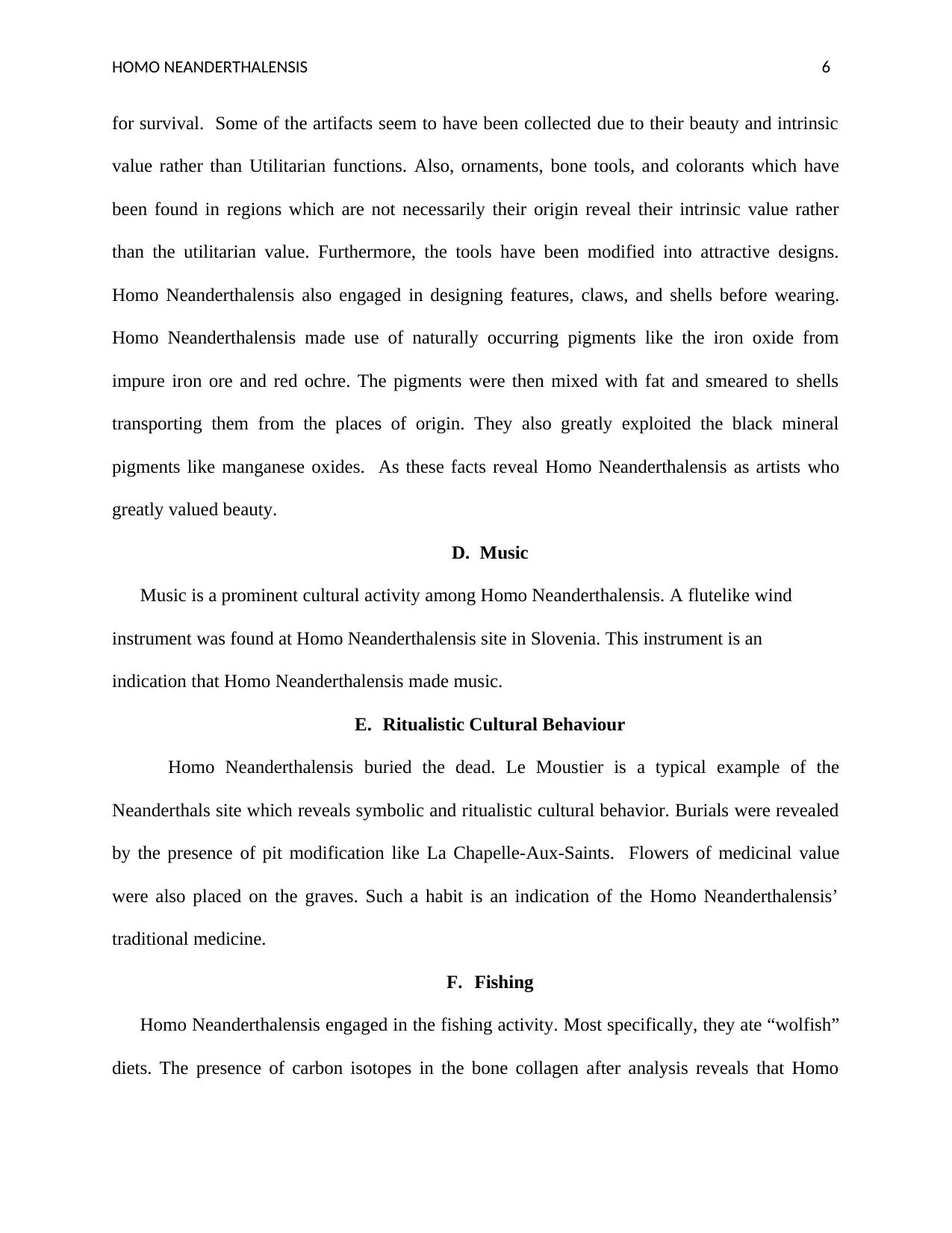
HOMO NEANDERTHALENSIS 6
for survival. Some of the artifacts seem to have been collected due to their beauty and intrinsic
value rather than Utilitarian functions. Also, ornaments, bone tools, and colorants which have
been found in regions which are not necessarily their origin reveal their intrinsic value rather
than the utilitarian value. Furthermore, the tools have been modified into attractive designs.
Homo Neanderthalensis also engaged in designing features, claws, and shells before wearing.
Homo Neanderthalensis made use of naturally occurring pigments like the iron oxide from
impure iron ore and red ochre. The pigments were then mixed with fat and smeared to shells
transporting them from the places of origin. They also greatly exploited the black mineral
pigments like manganese oxides. As these facts reveal Homo Neanderthalensis as artists who
greatly valued beauty.
D. Music
Music is a prominent cultural activity among Homo Neanderthalensis. A flutelike wind
instrument was found at Homo Neanderthalensis site in Slovenia. This instrument is an
indication that Homo Neanderthalensis made music.
E. Ritualistic Cultural Behaviour
Homo Neanderthalensis buried the dead. Le Moustier is a typical example of the
Neanderthals site which reveals symbolic and ritualistic cultural behavior. Burials were revealed
by the presence of pit modification like La Chapelle-Aux-Saints. Flowers of medicinal value
were also placed on the graves. Such a habit is an indication of the Homo Neanderthalensis’
traditional medicine.
F. Fishing
Homo Neanderthalensis engaged in the fishing activity. Most specifically, they ate “wolfish”
diets. The presence of carbon isotopes in the bone collagen after analysis reveals that Homo
for survival. Some of the artifacts seem to have been collected due to their beauty and intrinsic
value rather than Utilitarian functions. Also, ornaments, bone tools, and colorants which have
been found in regions which are not necessarily their origin reveal their intrinsic value rather
than the utilitarian value. Furthermore, the tools have been modified into attractive designs.
Homo Neanderthalensis also engaged in designing features, claws, and shells before wearing.
Homo Neanderthalensis made use of naturally occurring pigments like the iron oxide from
impure iron ore and red ochre. The pigments were then mixed with fat and smeared to shells
transporting them from the places of origin. They also greatly exploited the black mineral
pigments like manganese oxides. As these facts reveal Homo Neanderthalensis as artists who
greatly valued beauty.
D. Music
Music is a prominent cultural activity among Homo Neanderthalensis. A flutelike wind
instrument was found at Homo Neanderthalensis site in Slovenia. This instrument is an
indication that Homo Neanderthalensis made music.
E. Ritualistic Cultural Behaviour
Homo Neanderthalensis buried the dead. Le Moustier is a typical example of the
Neanderthals site which reveals symbolic and ritualistic cultural behavior. Burials were revealed
by the presence of pit modification like La Chapelle-Aux-Saints. Flowers of medicinal value
were also placed on the graves. Such a habit is an indication of the Homo Neanderthalensis’
traditional medicine.
F. Fishing
Homo Neanderthalensis engaged in the fishing activity. Most specifically, they ate “wolfish”
diets. The presence of carbon isotopes in the bone collagen after analysis reveals that Homo

HOMO NEANDERTHALENSIS 7
Neanderthalensis ate meals and diets that are similar to that of carnivores. They ate both
mollusks and fish.
v. Pathology and Trauma
The remains of Homo Neanderthalensis reveal enamel growth and defects such as arrested
development during the period of nutritional stress or illness in the childhood stages. The cut
marks found on the bones in remains which were found at Goyet in Belgium and El Sidron in
Spain is an indication of cannibalism. Traumatic lesions not only evidence traumatic injury but
also symbolize healing. The injuries sustained on the arms and head are linked to close contact
hunting which involves wrestling of the pray to death.
vi. Genetics
Research on the genetic composition of the Homo Neanderthalensis in relation to that of the
human being moved rapidly in the twenty-first century. In 2010, there came a composition of the
Neanderthal nuclear genetic sequence. The DNA revealed the likelihood of red hair and pale skin
among some of the Homo Neanderthalensis. Genetic studies of the remains collected from sites
with multiple individuals reveal the likelihood of the Homo Neanderthalensis lining in small
isolated, close-knit extended families. The genetic composition also revealed that male was
closely related which is an indication of patrilocality among the groups. DNA also reveals that
the Eurasian population is made up of 1-4% of the Homo Neanderthalensis gene composition.
vii. Homo Neanderthalensis and Modern Humans Interbred
Apart from the fact that Homo Neanderthalensis have been found to have lived together with
modern human beings at one point in time, DNA tests have revealed interbreeding between the
two (Estes, 2015). The mating took place in the middle east after modern humans have left
Africa. As a result, there existed a gene flow from the Homo Neanderthalensis to modern
Neanderthalensis ate meals and diets that are similar to that of carnivores. They ate both
mollusks and fish.
v. Pathology and Trauma
The remains of Homo Neanderthalensis reveal enamel growth and defects such as arrested
development during the period of nutritional stress or illness in the childhood stages. The cut
marks found on the bones in remains which were found at Goyet in Belgium and El Sidron in
Spain is an indication of cannibalism. Traumatic lesions not only evidence traumatic injury but
also symbolize healing. The injuries sustained on the arms and head are linked to close contact
hunting which involves wrestling of the pray to death.
vi. Genetics
Research on the genetic composition of the Homo Neanderthalensis in relation to that of the
human being moved rapidly in the twenty-first century. In 2010, there came a composition of the
Neanderthal nuclear genetic sequence. The DNA revealed the likelihood of red hair and pale skin
among some of the Homo Neanderthalensis. Genetic studies of the remains collected from sites
with multiple individuals reveal the likelihood of the Homo Neanderthalensis lining in small
isolated, close-knit extended families. The genetic composition also revealed that male was
closely related which is an indication of patrilocality among the groups. DNA also reveals that
the Eurasian population is made up of 1-4% of the Homo Neanderthalensis gene composition.
vii. Homo Neanderthalensis and Modern Humans Interbred
Apart from the fact that Homo Neanderthalensis have been found to have lived together with
modern human beings at one point in time, DNA tests have revealed interbreeding between the
two (Estes, 2015). The mating took place in the middle east after modern humans have left
Africa. As a result, there existed a gene flow from the Homo Neanderthalensis to modern
Paraphrase This Document
Need a fresh take? Get an instant paraphrase of this document with our AI Paraphraser
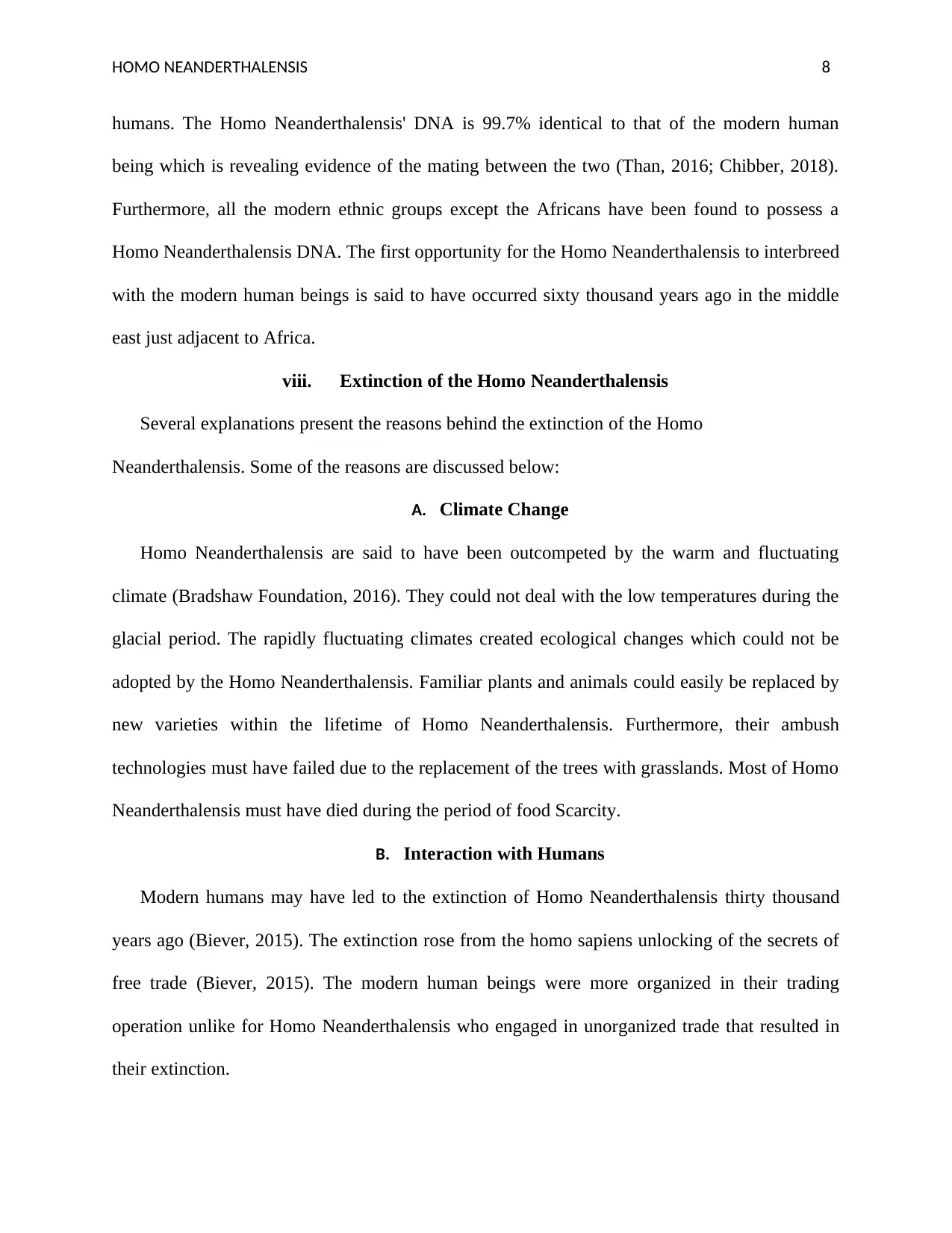
HOMO NEANDERTHALENSIS 8
humans. The Homo Neanderthalensis' DNA is 99.7% identical to that of the modern human
being which is revealing evidence of the mating between the two (Than, 2016; Chibber, 2018).
Furthermore, all the modern ethnic groups except the Africans have been found to possess a
Homo Neanderthalensis DNA. The first opportunity for the Homo Neanderthalensis to interbreed
with the modern human beings is said to have occurred sixty thousand years ago in the middle
east just adjacent to Africa.
viii. Extinction of the Homo Neanderthalensis
Several explanations present the reasons behind the extinction of the Homo
Neanderthalensis. Some of the reasons are discussed below:
A. Climate Change
Homo Neanderthalensis are said to have been outcompeted by the warm and fluctuating
climate (Bradshaw Foundation, 2016). They could not deal with the low temperatures during the
glacial period. The rapidly fluctuating climates created ecological changes which could not be
adopted by the Homo Neanderthalensis. Familiar plants and animals could easily be replaced by
new varieties within the lifetime of Homo Neanderthalensis. Furthermore, their ambush
technologies must have failed due to the replacement of the trees with grasslands. Most of Homo
Neanderthalensis must have died during the period of food Scarcity.
B. Interaction with Humans
Modern humans may have led to the extinction of Homo Neanderthalensis thirty thousand
years ago (Biever, 2015). The extinction rose from the homo sapiens unlocking of the secrets of
free trade (Biever, 2015). The modern human beings were more organized in their trading
operation unlike for Homo Neanderthalensis who engaged in unorganized trade that resulted in
their extinction.
humans. The Homo Neanderthalensis' DNA is 99.7% identical to that of the modern human
being which is revealing evidence of the mating between the two (Than, 2016; Chibber, 2018).
Furthermore, all the modern ethnic groups except the Africans have been found to possess a
Homo Neanderthalensis DNA. The first opportunity for the Homo Neanderthalensis to interbreed
with the modern human beings is said to have occurred sixty thousand years ago in the middle
east just adjacent to Africa.
viii. Extinction of the Homo Neanderthalensis
Several explanations present the reasons behind the extinction of the Homo
Neanderthalensis. Some of the reasons are discussed below:
A. Climate Change
Homo Neanderthalensis are said to have been outcompeted by the warm and fluctuating
climate (Bradshaw Foundation, 2016). They could not deal with the low temperatures during the
glacial period. The rapidly fluctuating climates created ecological changes which could not be
adopted by the Homo Neanderthalensis. Familiar plants and animals could easily be replaced by
new varieties within the lifetime of Homo Neanderthalensis. Furthermore, their ambush
technologies must have failed due to the replacement of the trees with grasslands. Most of Homo
Neanderthalensis must have died during the period of food Scarcity.
B. Interaction with Humans
Modern humans may have led to the extinction of Homo Neanderthalensis thirty thousand
years ago (Biever, 2015). The extinction rose from the homo sapiens unlocking of the secrets of
free trade (Biever, 2015). The modern human beings were more organized in their trading
operation unlike for Homo Neanderthalensis who engaged in unorganized trade that resulted in
their extinction.
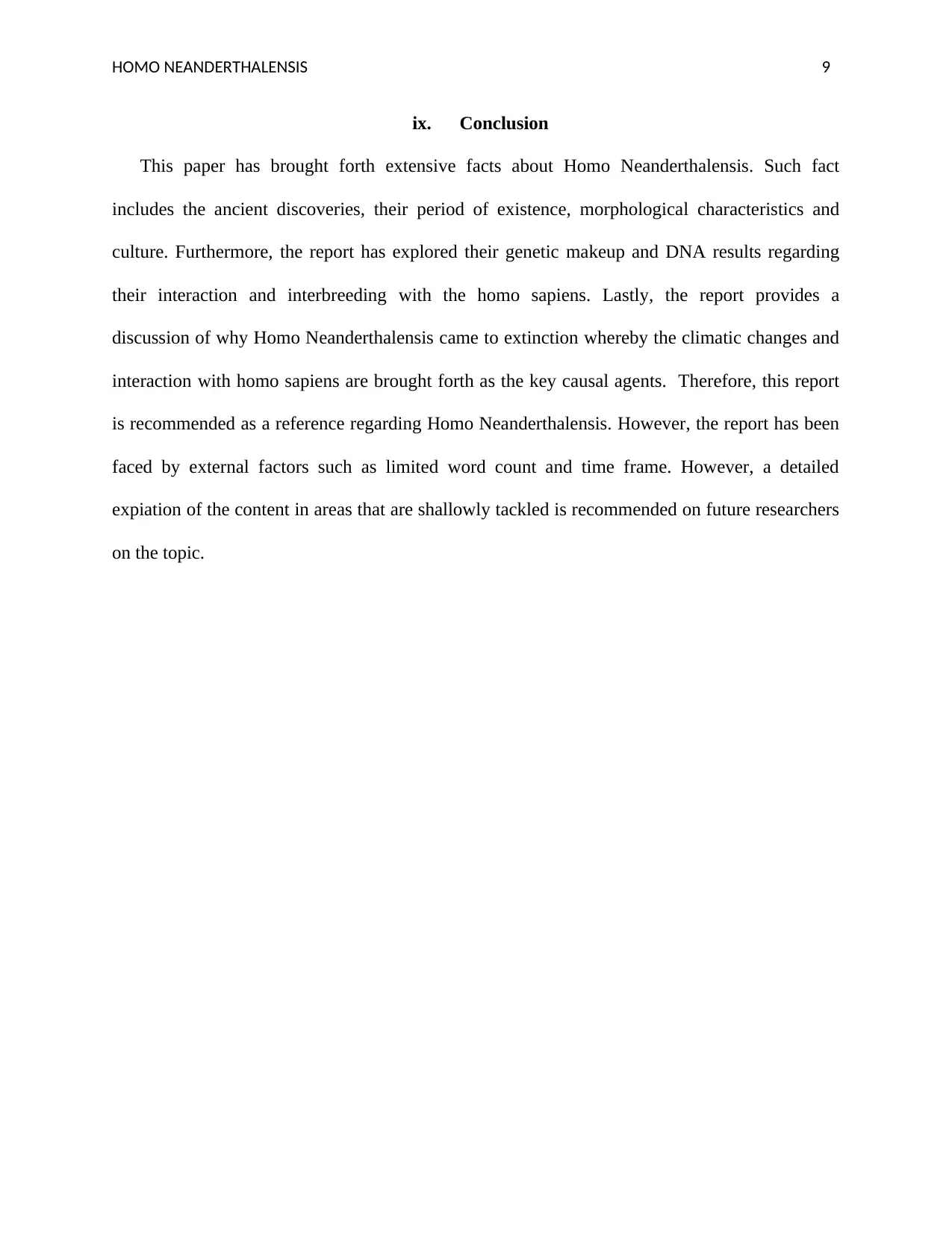
HOMO NEANDERTHALENSIS 9
ix. Conclusion
This paper has brought forth extensive facts about Homo Neanderthalensis. Such fact
includes the ancient discoveries, their period of existence, morphological characteristics and
culture. Furthermore, the report has explored their genetic makeup and DNA results regarding
their interaction and interbreeding with the homo sapiens. Lastly, the report provides a
discussion of why Homo Neanderthalensis came to extinction whereby the climatic changes and
interaction with homo sapiens are brought forth as the key causal agents. Therefore, this report
is recommended as a reference regarding Homo Neanderthalensis. However, the report has been
faced by external factors such as limited word count and time frame. However, a detailed
expiation of the content in areas that are shallowly tackled is recommended on future researchers
on the topic.
ix. Conclusion
This paper has brought forth extensive facts about Homo Neanderthalensis. Such fact
includes the ancient discoveries, their period of existence, morphological characteristics and
culture. Furthermore, the report has explored their genetic makeup and DNA results regarding
their interaction and interbreeding with the homo sapiens. Lastly, the report provides a
discussion of why Homo Neanderthalensis came to extinction whereby the climatic changes and
interaction with homo sapiens are brought forth as the key causal agents. Therefore, this report
is recommended as a reference regarding Homo Neanderthalensis. However, the report has been
faced by external factors such as limited word count and time frame. However, a detailed
expiation of the content in areas that are shallowly tackled is recommended on future researchers
on the topic.
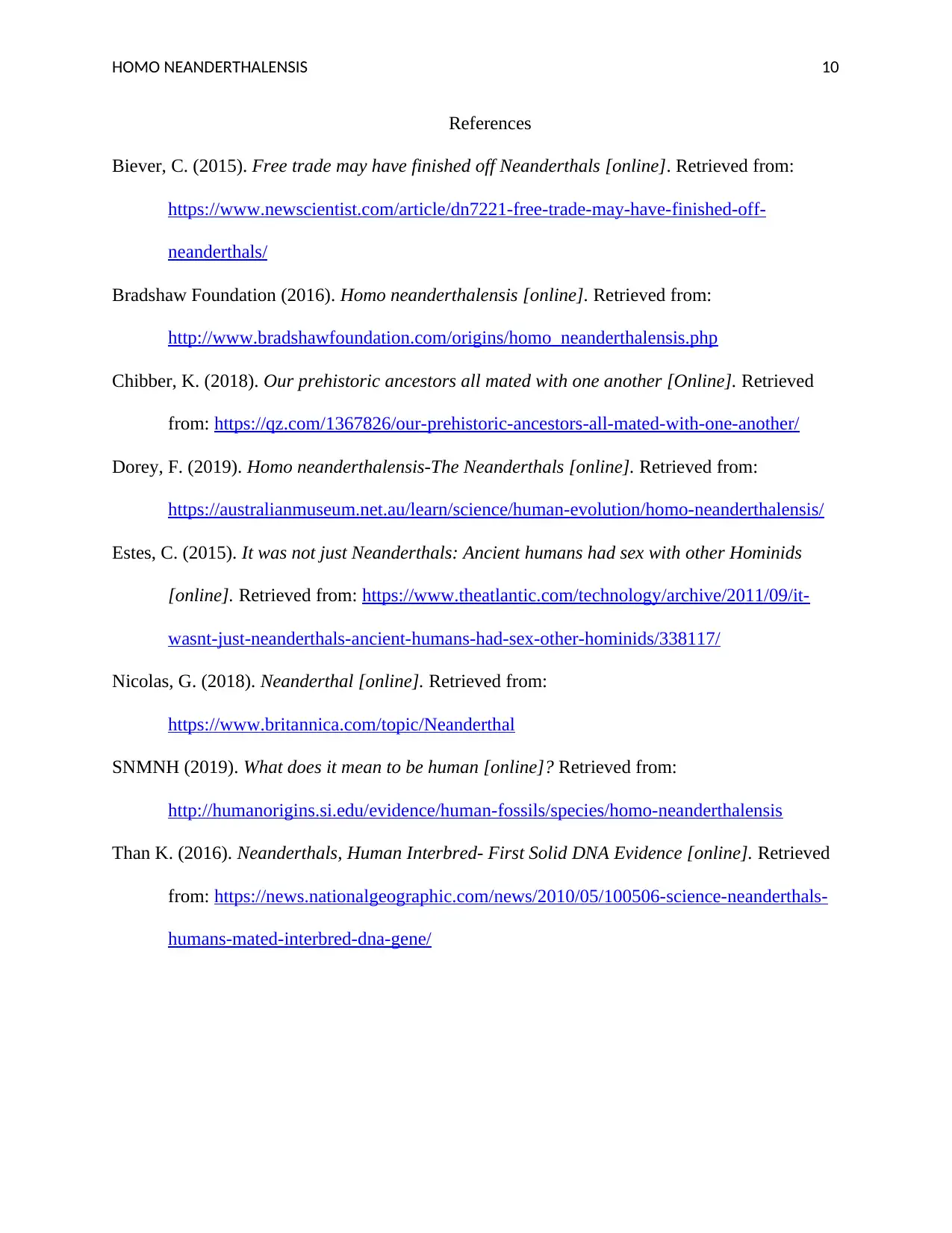
HOMO NEANDERTHALENSIS 10
References
Biever, C. (2015). Free trade may have finished off Neanderthals [online]. Retrieved from:
https://www.newscientist.com/article/dn7221-free-trade-may-have-finished-off-
neanderthals/
Bradshaw Foundation (2016). Homo neanderthalensis [online]. Retrieved from:
http://www.bradshawfoundation.com/origins/homo_neanderthalensis.php
Chibber, K. (2018). Our prehistoric ancestors all mated with one another [Online]. Retrieved
from: https://qz.com/1367826/our-prehistoric-ancestors-all-mated-with-one-another/
Dorey, F. (2019). Homo neanderthalensis-The Neanderthals [online]. Retrieved from:
https://australianmuseum.net.au/learn/science/human-evolution/homo-neanderthalensis/
Estes, C. (2015). It was not just Neanderthals: Ancient humans had sex with other Hominids
[online]. Retrieved from: https://www.theatlantic.com/technology/archive/2011/09/it-
wasnt-just-neanderthals-ancient-humans-had-sex-other-hominids/338117/
Nicolas, G. (2018). Neanderthal [online]. Retrieved from:
https://www.britannica.com/topic/Neanderthal
SNMNH (2019). What does it mean to be human [online]? Retrieved from:
http://humanorigins.si.edu/evidence/human-fossils/species/homo-neanderthalensis
Than K. (2016). Neanderthals, Human Interbred- First Solid DNA Evidence [online]. Retrieved
from: https://news.nationalgeographic.com/news/2010/05/100506-science-neanderthals-
humans-mated-interbred-dna-gene/
References
Biever, C. (2015). Free trade may have finished off Neanderthals [online]. Retrieved from:
https://www.newscientist.com/article/dn7221-free-trade-may-have-finished-off-
neanderthals/
Bradshaw Foundation (2016). Homo neanderthalensis [online]. Retrieved from:
http://www.bradshawfoundation.com/origins/homo_neanderthalensis.php
Chibber, K. (2018). Our prehistoric ancestors all mated with one another [Online]. Retrieved
from: https://qz.com/1367826/our-prehistoric-ancestors-all-mated-with-one-another/
Dorey, F. (2019). Homo neanderthalensis-The Neanderthals [online]. Retrieved from:
https://australianmuseum.net.au/learn/science/human-evolution/homo-neanderthalensis/
Estes, C. (2015). It was not just Neanderthals: Ancient humans had sex with other Hominids
[online]. Retrieved from: https://www.theatlantic.com/technology/archive/2011/09/it-
wasnt-just-neanderthals-ancient-humans-had-sex-other-hominids/338117/
Nicolas, G. (2018). Neanderthal [online]. Retrieved from:
https://www.britannica.com/topic/Neanderthal
SNMNH (2019). What does it mean to be human [online]? Retrieved from:
http://humanorigins.si.edu/evidence/human-fossils/species/homo-neanderthalensis
Than K. (2016). Neanderthals, Human Interbred- First Solid DNA Evidence [online]. Retrieved
from: https://news.nationalgeographic.com/news/2010/05/100506-science-neanderthals-
humans-mated-interbred-dna-gene/
1 out of 10
Related Documents
Your All-in-One AI-Powered Toolkit for Academic Success.
+13062052269
info@desklib.com
Available 24*7 on WhatsApp / Email
![[object Object]](/_next/static/media/star-bottom.7253800d.svg)
Unlock your academic potential
© 2024 | Zucol Services PVT LTD | All rights reserved.
